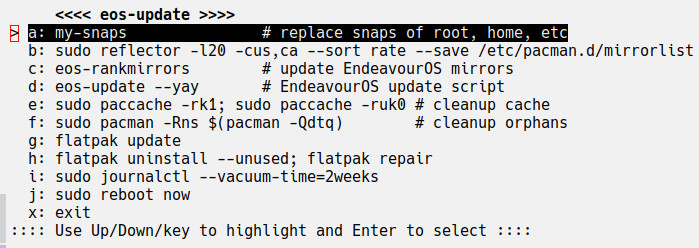Menu for Fuzzy Linux Procedures
Project description
rungs -- A Tool for Fuzzy Procedures
rungs is a tool help navigate "fuzzy" procedures on Linux where you might want to:
- skip certain steps if certain vague criteria are met
- repeat certain steps if they failed and trying again makes sense
You very simply specify your procedures within a single .ini file.
Quick Start: from the CLI
- If
python3 -Vshows v3.11 or later, install usingpipx:
python3 -m pip install --user pipx # if pipx not installedpython3 -m pipx ensurepath # if needed (restart terminal)pipx upgrade rungs || pipx install rungs # to install/upgrade- Else for python3.10 and lesser versions, install using
pip:
python3 -m pip install --user --upgrade rungs- To run:
rungs # to run and show all menusrungs {menu-name} # run the specified menurungs --edit # edit your menus
Mnemonic: step through the rungs of your laddered procedure ;-)
A Practical Example -- Manually Updating EndeavourOS
Here is an example menu for manually update an EndeavourOS:
Notes:
- Except for the first personal command, all commands are standard on EndeavourOS.
- All commands are run literally by
bashexcept:exitwhich means exit the menu.rungs {menu-name}runs rungs recursively usingpython3
- To run a command:
- highlight the command by typing the "key" before the ':' or move the cursor with the up/down arrow keys.
- then press ENTER.
- After the command runs, the next command is highlighted and runs with just ENTER if desired.
- To, repeat and skip commands, just select another command rather than the next.
- IMPORTANT: If the menu does not fit within your terminal, then resize until it does fit.
rungs Config: ~/.config/rungs/rungs.ini
Edit ~/.config/rungs/rungs.ini to configure your menu. The "eos-update-menu" was configured by adding this section:
[eos-update]
a: my-snaps # replace snaps of root, home, etc
b: sudo reflector -l20 -cus,ca --sort rate --save /etc/pacman.d/mirrorlist
c: eos-rankmirrors # update EndeavourOS mirrors
d: eos-update --yay # EndeavourOS update script
e: sudo paccache -rk1; sudo paccache -ruk0 # cleanup cache
f: sudo pacman -Rns $(pacman -Qdtq) # cleanup orphans
g: flatpak update
h: flatpak uninstall --unused; flatpak repair
i: sudo journalctl --vacuum-time=2weeks
j: sudo reboot now
x: exit
So, the config looks nearly the same as the menu, but if you specify a multiline value, then:
- the first line is shown, and
- the subsequent lines are given to bash literally.
In this manner, for very complicated commands, you can provide a summary description of what is to be run.
Additionally:
- keys must be a single character and unique
- if you specify an multicharacter key, only the lead character is used in the menu
rungs Command Line
usage: rungs [-h] [-e] [-n] [menus ...]
positional arguments:
menus zero or more arguments
options:
-h, --help show this help message and exit
-e, --edit edit config (i.e., runs edit-rungs-config)
-n, --dry-run show commands w/o running them
Thus, you can:
- run
rungs --editto edit the configuration file. - run
rungswith no arguments to given a menu of all the "ordinary" menus. - provide the name specifiers of the menus to run them; each name spec can match:
- exactly,
- case independent exactly (if unique and ordinary),
- or case independent substring match but only at word boundaries (if unique and ordinary); e.g., for the menus,
['edit-rungs-config', 'example', 'eos-update']:- these name specs would find a menu: 'edit', 'ex', 'EOS-', 'EOS-UPDATE'
- these name specs would NOT: 'date', 'e'.
"Special" (vs "Ordinary") menu names begin with character other than [_A-Za-z0-9], and are excluded from being run unless given the whole, exact, memory sensitive name. A suggested naming convention for menus:
- beginning
>for a sub-menu that should not be called independently - beginning
!for a deprecated menu (but not ready to remove it)
The Edit Menu and Handling Corrupt .ini Files
On first startup, the .ini file contains a menu for editing that you may customize:
[edit-rungs-config]
a: ${EDITOR=-vi} ~/.config/rungs/rungs.ini
x: exit
[example]
a: command-a
b: prompt-b
command-b
x: exit
For example, you might change the default from vi to geany if installed and desired. Also, note:
- You may remove the
examplewhich shows a multilined value which must be indented lines after the first. - Do NOT remove the
edit-rungs-configmenu; it is needed for--editoption AND recovery. - The
edit-rungs-configshows how to pass variables to your commands. - In case of a corrupt
.ini, you will see the error and theedit-rungs-configmenu. - Each time the
.inifile is read and valid,~/.config/rungs/rungs.ini.bakis written; in the case you just made a terrible change, recover using the.ini.bakfile manually (w/o runningrungs -e).
Practical Examples
The examples subdirectory includes more practical examples, including
- A two-level menu for Fedora updates and release upgrades.
These menus many not be current and are not tested; use only after reviewing for correctness and completeness.
Project details
Release history Release notifications | RSS feed
Download files
Download the file for your platform. If you're not sure which to choose, learn more about installing packages.












